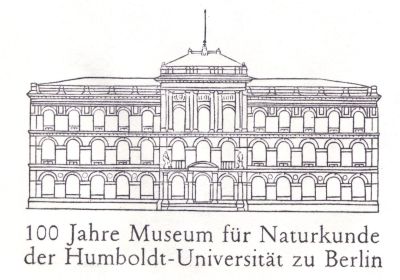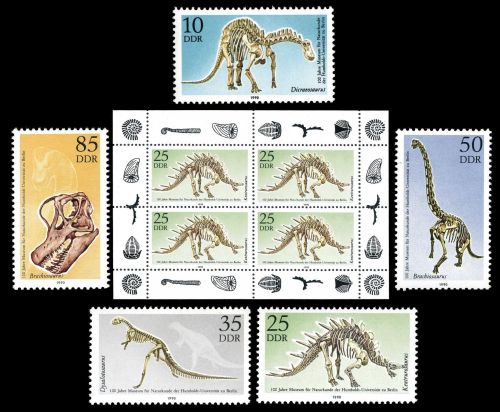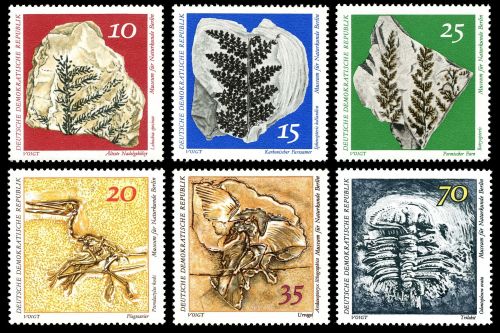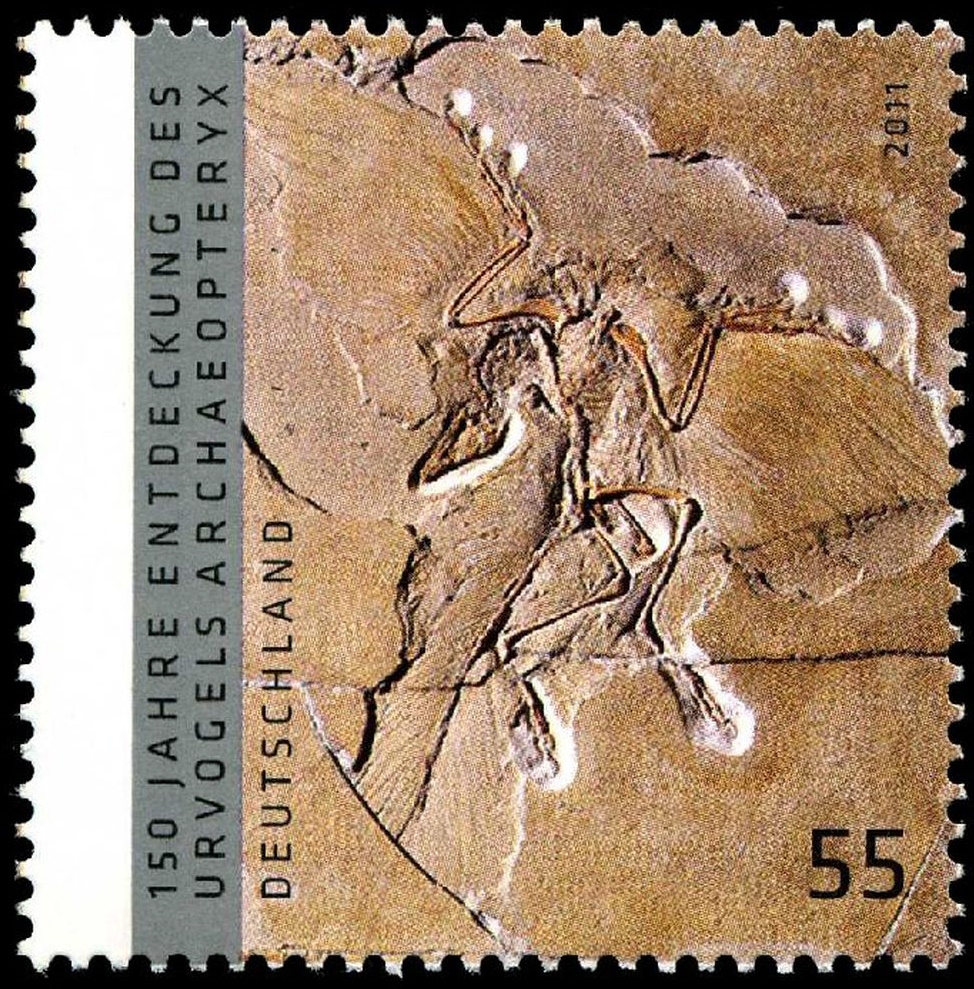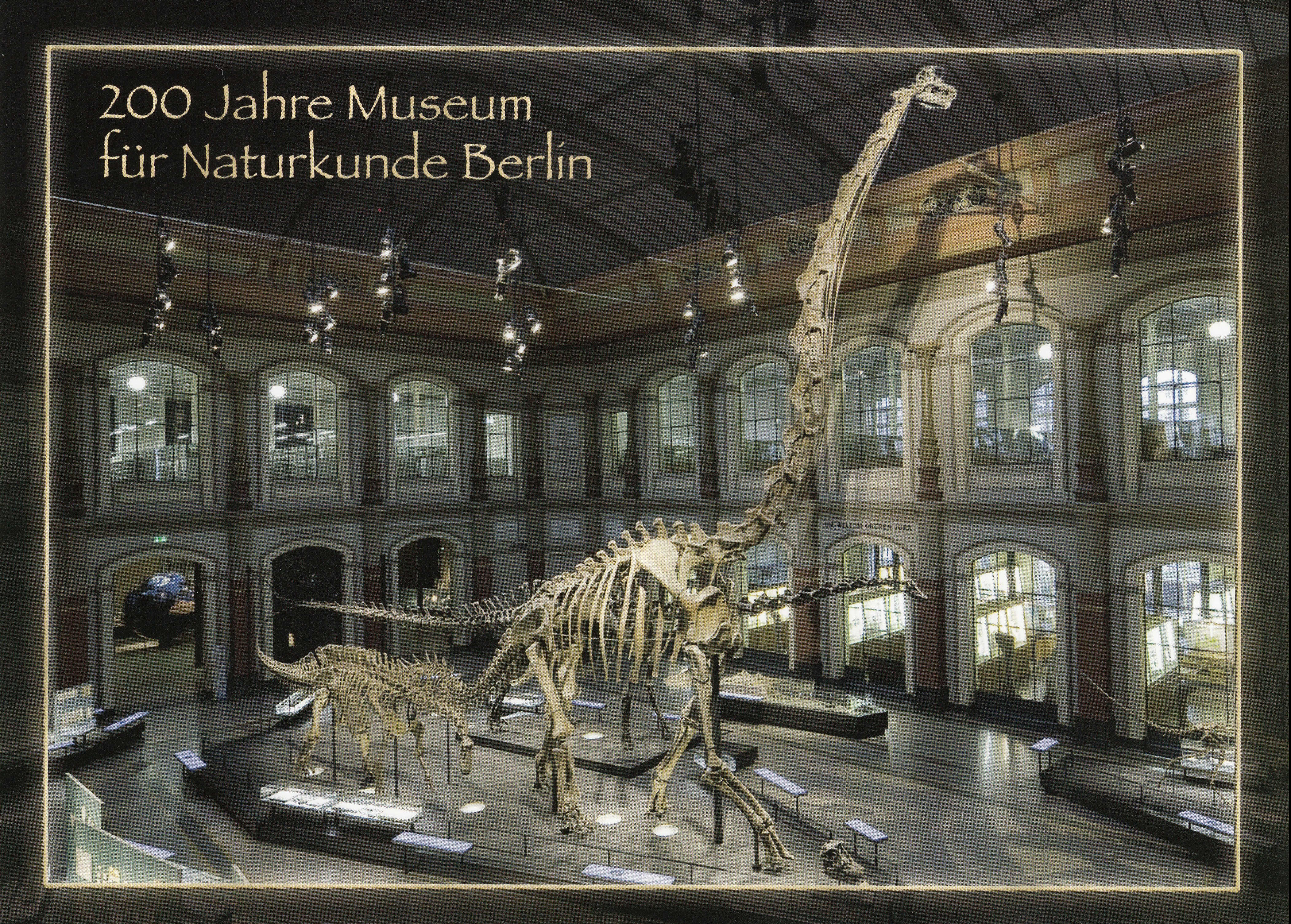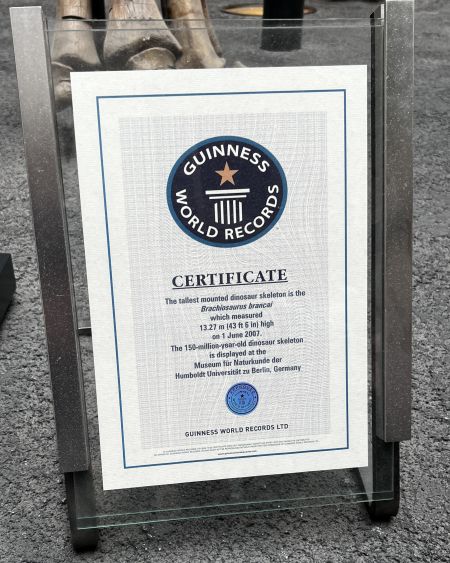Germany 2010 "Bicentenary of Nature Science Museum in Berlin"
| <prev | back to index | next> |
| Issue Date | 02.01.2010 |
| ID | Gummed | self-adhesive Michel: 2775 | 2780; Scott: 2555 | 2556; Stanley Gibbons: 3630 | 3631; Yvert et Tellier: 2603 | 2604; Category: pF |
| Design | Ernst Juenger, Hans Michel |
| Stamps in set | 1 |
| Value | Euro 0.45 - skeleton of Brachiosaurus brancai and stuffed animals from collection of Nature Science Museum in Berlin. |
| Size (width x height) | gummed stamp: 44.2mm x 26.2mm self-adhesive stamp: 39.0mm x 23.0mm |
| Layout | MS of 10 stamps both mint and self-adhesive |
| Products | FDC x2, FDS x2, Anniversary letter x1 |
| Paper | stroke, white, fluoresce, special post paper DP 2 |
| Perforation | gummed stamp: 13,5 x 13 self-adhesive: die cut 10 |
| Print Technique | Multicolor offset print |
| Printed by | Giesecke & Devrient GmbH, Wertpapierdruckerei Leipzig |
| Quantity |
gummed stamp: 12.000.000, of which
74.000 on First-Day-Sheets self-adhesive stamp: 192.107.200 |
| Issuing Authority | The Federal Ministry of Finance (Deutsche Post) |
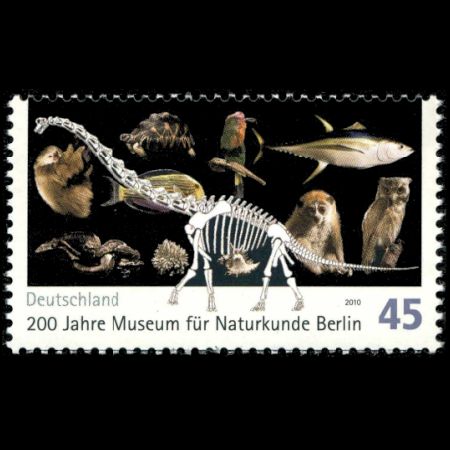
On January 2nd, 2010, the Post Authority of Germany issued the stamp "Bicentenary of Nature Science Museum in Berlin" (in German: 200 Jahre Museum für Naturkunde Berlin) The stamp was printed in two variants: gummed and self-adhesive.
 |
| Size compare of gummed and self-adhesive stamps |
 |
| The images from the reverse side of the Mini-Sheet of the self-adhesive stamp |
Both stamps were printed in Mini-Sheets of 10. The reverse side of the Mini-Sheet of the self-adhesive stamp contain a photo of Allosaurus fragilis with reconstructed head from the exhibit of the Museum, cut model of the Earth and the front side of the main building of the Museum.
Stylized Ammonites were depicted on the margins of the Mini-Sheet with the gummed stamp. Many stuffed animals and shells from collection of the Museum are shown on the background of the stamp. The most famous artefact of the museum the 14-meter-high, the biggest mounted dinosaur skeleton of the world - the skeleton of sauropod dinosaur Brachiosaurus brancai - depicted on the foreground.
Note:
Brachiosaurus brancai was described by German paleontologist Werner Janensch
in 1914, based on the fossils discovered in what was then German East Africa, modern-day Tanzania,
as species of the North American sauropod Brachiosaurus from the Morrison Formation, USA.
Recent research shows that the differences between the type species of Brachiosaurus
and the Tanzanian fossils are so large that the African material should be placed in a separate genus.
From 2012 onward most studies recognized the species as Giraffatitan brancai,
instead of Brachiosaurus brancai.
However, due to the fact all articles about the stamp written in 2010, books printed by
Nature Science Museum in Berlin after 2012, such as "Museum für Naturkunde, the Exhibition",
(English edition) published in 2019, ISBN 978-3-946512-1-14-1, and the website of the Museum
(accessed in March 2024) continue to use the original name,
Brachiosaurus brancai use in this article too.

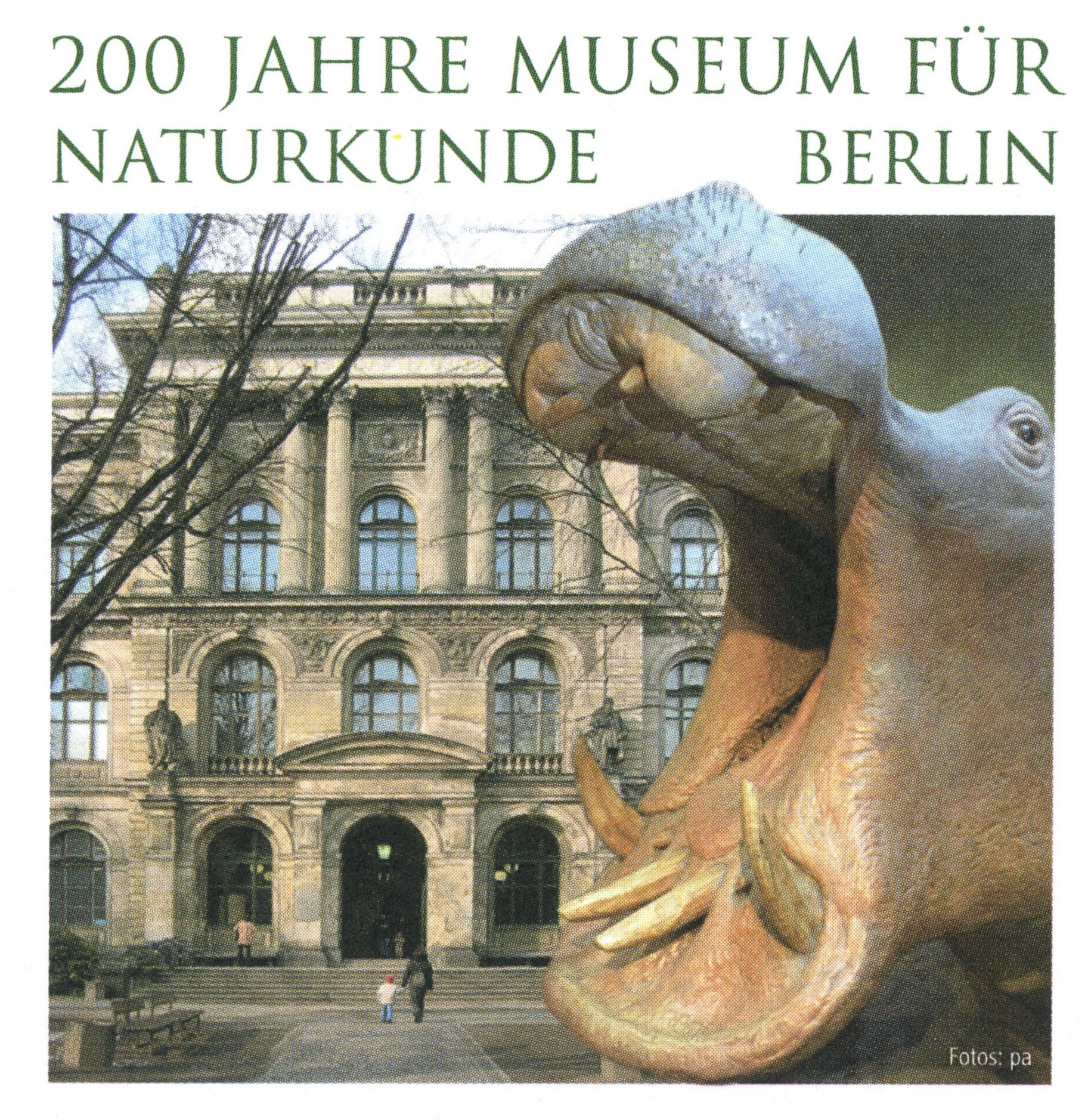 |
| The main building of Museum of Natural Science (in German: Das Museum für Naturkunde) in Berlin on cachet of the official FDC of Germany 2010. |
- The content of th exhibition should be developed by their own scientists.
- When choosing the exhibits, originals from their collection should be display wherever possible. Were fossils replicas are shown, they are labelled as such.
The Museum of Natural Science in Berlin is a merger of three museums that came into being in 1810 when Berlin’s Friedrich-Wilhelms-Universitaet Unter den Linden was founded:
- the Anatomical-Zootomical Museum
- the Mineralogical Museum (from 1814)
- the Zoological Museum
The museum of Mineralogy was a successor to the Royal Mineral Cabinet. Its treasures included paleontological finds from the collection of Freiherr von Schlotheim, Leopold von Buch and Alexandr von Humbolt.
The museum's name has changed several times. The museum was founded in 1810 as a part of the Berlin University, which changed its name to Humboldt University of Berlin in 1949. For much of its history, the museum was known as the "Humboldt Museum", but in 2009 it left the University to join the Leibniz Association. The current official name is "Museum für Naturkunde – Leibniz-Institut für Evolutions- und Biodiversitätsforschung" (in English Museum of Natural History – Leibniz Institute for Evolution and Biodiversity Research) and the "Humboldt" name is no longer related to this museum. Furthermore: there is another Humboldt-Museum in Berlin dealing with brothers Wilhelm and Alexander von Humboldt.
By 1880, the collections filled two thirds of the University’s main building so that a new building, that could house all three collection had to be erected.On December 2nd 1889, the Emperor Wilhelm II officially opened the new museum in Invalidenstrasse. It was supposed to become the hub of a new agglomeration of institutes and museums dedicated to science and technology.
The dinosaur-fossils stamps of German Democratic Republic from 1990, where issued on occasion of 100th anniversary of openings of the Museum.
The generously sized exhibition halls are arranged around a large atrium that forms the heart of the public display area. Contrary to the initial plans, not all collections became accessible to the public, but they were separated into a display collection and a main collection. This was a revolutionary idea at the time which was then imitated everywhere. As the Zoological collection grew up very quickly, an annex was added to the building in 1917.In 1937 dinosaur skeletons, discovered by German paleontologist in East Africa in 1909, were exhibited in the main hall of the museum for the first time. These skeletons appeared on stamps of German Democratic Republic in 1990 (see on the right).
In February 1945 the East wing of the museum was destroyed by the bomb attack of allied air forces and was rebuilt only in 2011. Fortunately, the majority of specimens – 75% of the collection, including the dinosaurs – could be saved. Once the war had ended, the Museum of Natural Science was the first museum in Berlin to reopen its gates, on September 16th 1945.
After the fall of the Berlin wall and reunification in 1989/90, the Museum was first restructured into three Institutes for Mineralogy,
Today, collection of the museum comprises over 30 million items, including almost 3 million fossils and almost 180,000 holotypes (specimens on which the first description of the species was based).
Museum of Natural Science in Berlin is a research museum within the Leibniz Association. It is one of the most significant research institutions worldwide in biological and geo-scientific evolution research and biodiversity.
The Collections of the Museum are directly linked to research. This is due not only to the fact that the collections have been compiled continuously for over 200 years, but also to some spectacular pieces such as:
- the "Berlin specimen" of the primeval bird Archaeopteryx lithographica
- one of the best preserved skeletons of Tyrannosaurus rex, nickname "Tristan"
- the original piece of uranium on which its first scientific description was based
- the Bloch Collection from the 18th century, probably the oldest preserved fish collection in the world
- the mineral collection representing 75% of the minerals in the world, including the largest piece of amber in the world.
The main hall of the Museum, the atrium, contains the exhibition that takes the visitors back in time 150 million years ago. It shows fossils of prehistoric animals and plants that inhabitated the Earth during the Upper Jurassic, including five dinosaur skeletons discovered by paleontologist of the Museum during their expedition in what was then German East Africa, modern-day Tanzania, between 1909 and 1913:
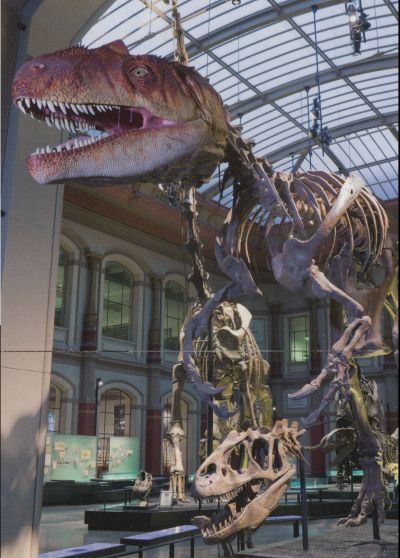 |
| Cast of Allosaurus fragilis skeleton with the head reconstruction, on postcard of of Natural Science Museum in Berlin. |
- Brachiosaurus brancai - a member of the Sauropods group - the tallest mounted dinosaur skeleton in the world
- Kentrosaurus aethiopicus - a member of the Stegosaurus group
- Dysalotosaurus lettowvorbecki - small (2.5 meter in length) herbivorous iguanodontian dinosaur.
- Dicraeosaurus hansemanni - a mid-sized diplodocoid sauropod dinosaur
- Allosaurus fragilis - a member of the Theropoda dinosaurs - as the expedition merely yielded a few bones of the animal, the Allosaurus skeleton in the exhibition is a cast.
In 1899, when crew members from the Carnegie Museum of Natural History were collecting
fossils in the Morrison Formation of Sheep Creek, Wyoming, with funding from Scottish-American
steel tycoon Andrew Carnegie, they discovered a massive and well preserved skeleton of Diplodocus.
Another vey well preserved skeleton of Diplodocus was discovered at the same place
in the following year.
In 1907 the Carnegie Museum of Natural History created a composite mount of Diplodocus carnegii that incorporated
bones of both skeletons.
The skeleton became very popular, being nicknamed "Dippy".
The goal of Carnegie in sending these casts overseas was apparently to bring international unity and
mutual interest around the discovery of the dinosaur.
One of the most famous fossils of the paleontological exhibition of the Museum is 14 meter long skeleton of Brachiosaurus brancai, depicted on the stamp. In 2007, visitors gave it its official nickname, "Oskar". The skeleton was built from 65% of original bones. Most of the bones are from the same individual, the missing bones of another individual of the same species were used to create the composite mounted skeleton seen today.
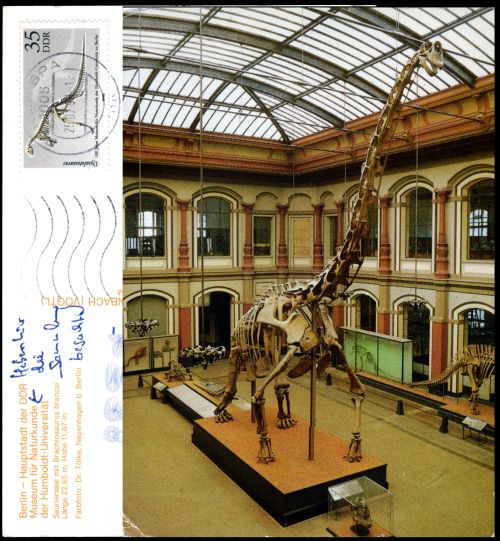 |
|
The view of the atrium of the Natural History Museum in Berlin
on the postcard of German Democratic Republic from 1990. |
In the late 19th and early 20th centuries dinosaur finds were very rare in Europe, so having a real dinosaur of its own was a turning point for the reputation and fame of the Museum für Naturkunde by giving it a real specimen of great scientific importance, in contrast to plaster casts from North America that normally featured in European museums.
During the World War II, it was unmounted and placed in the Museum’s basement for safekeeping, returned to public view in 1953 in the then-divided city, and finally re-analyzed and reassembled in 2007 on the basis of the latest scientific findings and reconstruction techniques, with erected legs (see on the postcard attached to the "Anniversary Letter", below).A new scientific name was given to Brachiosaurus in 2009, when differences in the shape, size and proportions of the bones led to the distinction between a North American and an African Brachiosaurus genus.
Thus, Brachiosaurus brancai became Giraffatitan brancai. This is now the scientifically recognised name used by researchers.
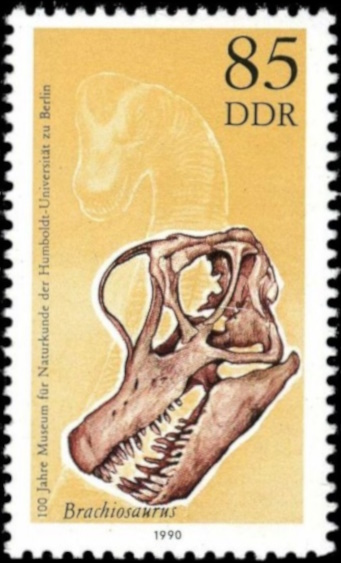 |
|
The skull and head reconstruction of Brachiosaurus/Giraffatitan brancai on the stamp of German Democratic Republic from 1990. |
Giraffatitan is a genus of sauropod dinosaur that lived during the late Jurassic Period (Kimmeridgian–Tithonian stages) in what is now Lindi Region of Tanzania.
During "Tendaguru" paleoontological expedition of
the Natural History Museum in Berlin between 1909 and 1913,
led by German paleontologist Werner Janensch
many dinosaurs fossils at Mount Tendaguru in what was then German East
Africa, modern-day Lindi Region of Tanzania
were unearthed.
Brachiosaurus bones of several individuals were used
to create the composite mounted skeleton seen today.
The species name brancai was named in honor of German paleontologist
Wilhelm von Branca, who was a driving force behind the expedition that
discovered it in the Tendaguru Formation and who was director of the Museum.
At Tendaguru, explorers found not only dinosaurs, but also other fossilised animals and plants.
The presence of marine fossils suggest that on the foreshore of what is now the Tanzanian coast,
there were mud flats and lagoons, sheltered from the open sea by reefs, but allowing a constant
exchange of water with the open sea.
Some 230 tonnes of fossil bones, of several dinosaur species, fishes and plants,
were excavated and sent to Berlin.
The lungs of sauropod dinosaurs worked twice more efficient as mammalinas lungs, due to a special air-sacks system, which also reduced the wieght of the giants by much. The heart of the dinosaur must have weight at least 400 kg, to build enormous pressure in order to pump blood to the head.
The extremely well preserved skull of the Giraffatitan is a sensation find, as complete skulls of sauropods are very rare. The cast of the skull can be seen next to the dinosaur skeleton in the atrium of the Museum. The original skull is fragile, therefore it is stored in the Museum and available for paleontological study only.
Scientists all over the world are puzzling how much a live Giraffatitan actually weighed. Some have calculated a mass of 50 tonnes, whereas others think it was just 20 to 30 tonnes. Furthermore, they are interested in the static and physiological problems a dinosaur this size had to overcome.
A famous specimen of Brachiosaurus/Giraffatitan brancai mounted in the Berlin's Natural History Museum is one of the largest, and in fact the tallest, mounted skeletons in the world, as certified by the Guinness Book of Records.
The tallest mounted dinosaur skeleton is that of the Brachiosaurus brancai, which measured 13.27 meter
high on 1 June 2007.
The 150-million-year-old dinosaur skeleton went back on permanent display at
the Museum für Naturkunde der Humboldt Universität zu Berlin
(Berlin Natural History Museum), Germany in 2007, having been displayed originally in 1937.
The skeleton has been reconstructed according to scientific agreement on how this dinosaur
species used to walk 150 million years ago.
The bones are to 65% original fossils.
The rest is a model of fossil pieces that exist in the museum’s collection but
cannot be used in the construction, due to the sensitivity of the material.
The record measurement, above, is worked out by:
1st measurement of height from head to ground.
2nd measurement of height from head to claw tip on the hind right foot.
Then subtracting the second measurement from the first = 13.27 m.
It was measured using the laser analyser Leica DISTO classic.
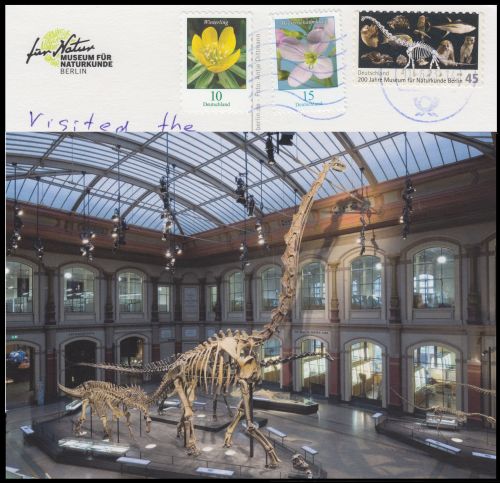 |
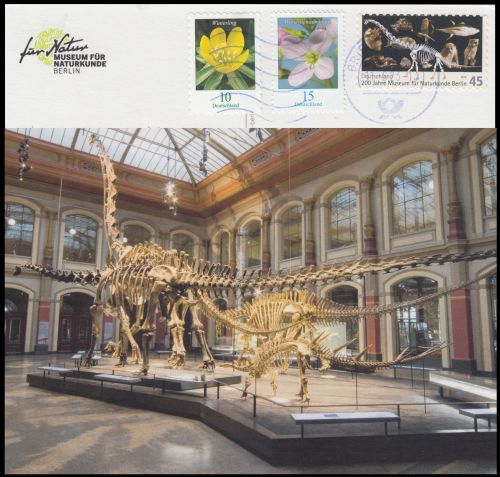 |
| The view of the atrium, after reconstruction in 2007, on the postcard of Germany, posted in 2023, with new posture of Brachiosaurus brancai skeleton. | |
Products and associated philatelic items
| First-Day-of-Issue Postmarks | ||||
|
There are three postmarks issued with the stamp: two postmarks of
Bonn and one of Berlin. The postmark of Berlin was used on the official FDC of Deutsche Post with gummed stamp and on the "Anniversary Letter". Two postmarks were used by the Bonn Post Office - one on the First-Day-Sheet with gummed stamps and another one the official FDC with self-adhesive stamp. An additional postmark from Berlin was issued three days after the stamp issue day. |
||||
| Postmarks for gummed stamp | Postmark for self-adhesive stamp | Additional Postmark | ||
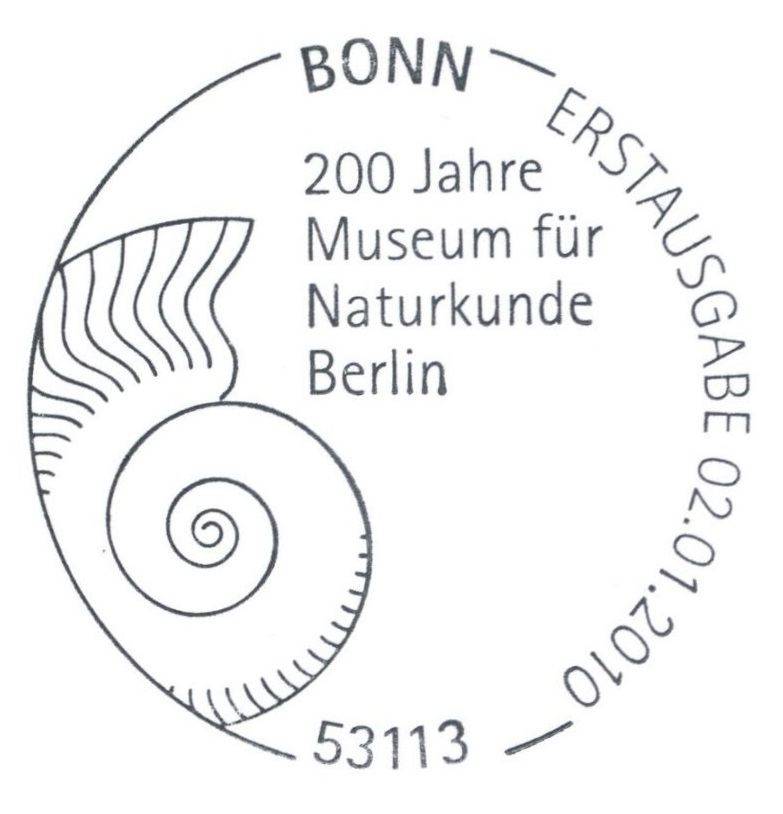 |
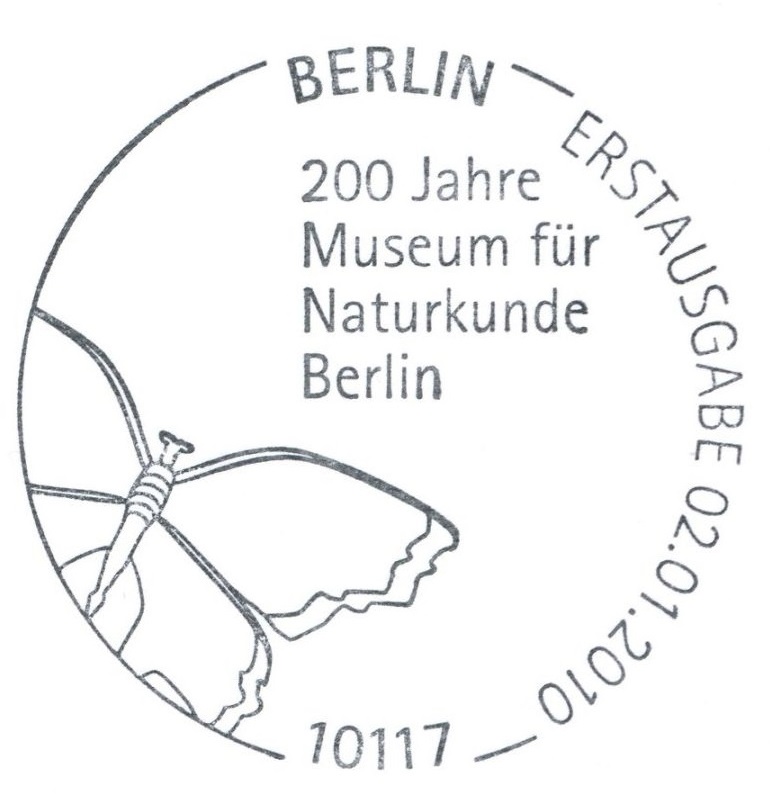 |
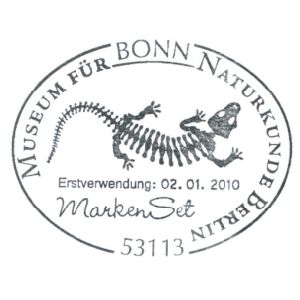 |
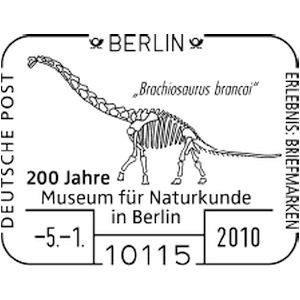 |
|
| Official FDC | Personalized FDC | |
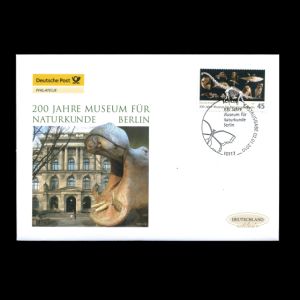 |
 |
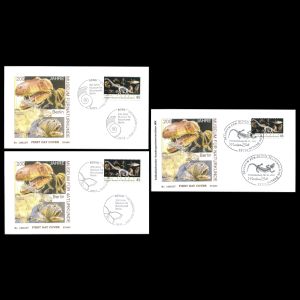 |
| Official FDC with gummed stamp and postmark of Berlin | Official FDC with self-adhesive stamp and postmark of Bonn | |
| Anniversary Letter | ||
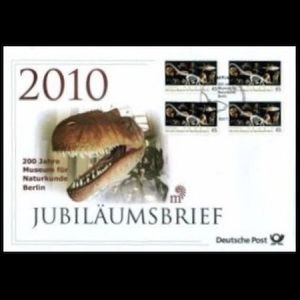 |
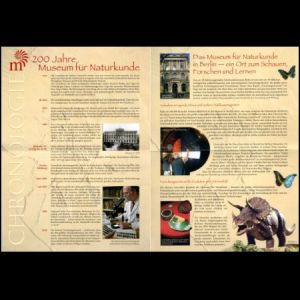 |
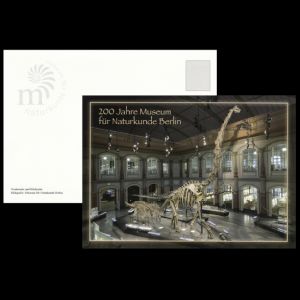 |
| Anniversary Letter (C5 in size), with four gummed stamps and postmark of Berlin. The Anniversary Letter contain the "letter" and a big size postcard. | ||
| Mini-Sheets (gummed and self-adhesive stamps) | Postal stationery | |
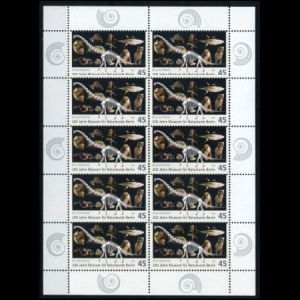 |
 |
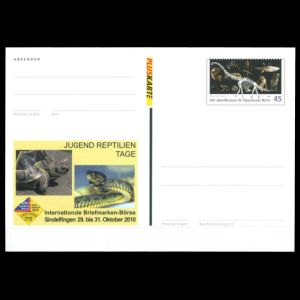 |
| This postal stationery was issued in October 2010 for the International Stamps Tradeshow in Sindelfingen (near Stuttgart). | ||
| Souvenirs and commemorative materials | ||
| First-Day-Sheets (gummed stamp) | Souvenir Booklet with images of some drafts | Souvenir Booklet of Deutsche Post |
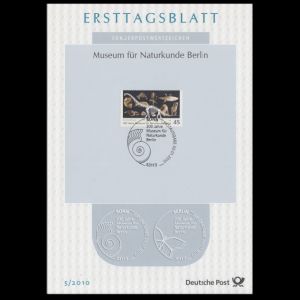 |
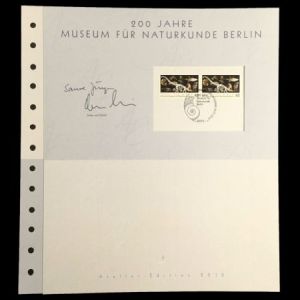 |
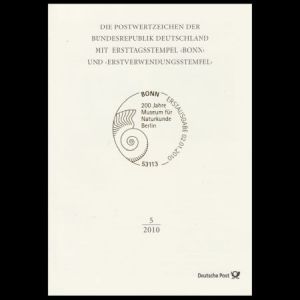 |
| First-Day-Sheets (self-adhesive stamps) | ||
 |
|
|
| The First-Day-Sheet with self-adhesive stamp was issued in June 2010 and was shared with self-adhesive stamps of the first half of 2010. | ||
| Example of circulated covers | ||
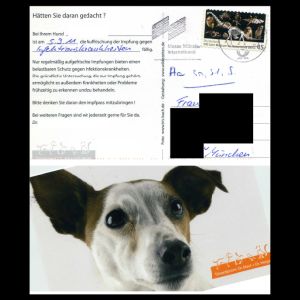 |
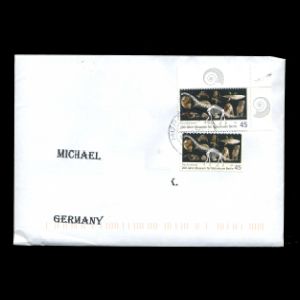 |
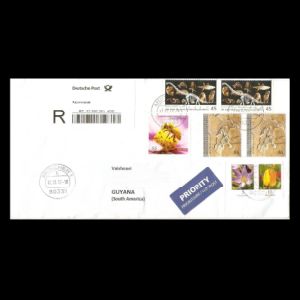 |
| The stamp "Bicentenary of Museum fuer Naturkunde in Berlin" on postcard sent in Munich in 2011. | Two stamps with the postcards rate were equal to domestic letter with weight up to 50g rate. | "Bicentenary of Museum fuer Naturkunde in Berlin" and "Archaeopteryx" stamps on International registered letter. |
References

|
 |
|
"Dinosaurierfragmente: Zur Geschichte der Tendaguru-Expedition und ihrer Objekte, 1906-2018",
Ina Heumann, Holger Stoecker, Marco Tamborini, Mareike Vennen. Published in 2018. Amazon: USA, UK, DE. |
|
|
-
Technical details and stamps presentation:
First-Day-Sheet, Colnect: gummed stamp, self-adhesive stamp, -
The Natural History Museum in Berlin:
- Wikipedia
- official website
- The World of Dinosaurs (NHM Berlin)
- YouTube Channel - most of the videos have German audio, but the subtitles are available in English. e.g.:
- "Museum für Naturkunde, the Exhibition", (English edition) published in 2019, ISBN 978-3-946512-1-14-1
- Brachiosaurus:
- Giraffatitan:
- Tendaguru Formation:
-
Tendaguru Expedition (1909-1913):
- Natural History Museum in Berlin
- geschichte.fm (in German)
- Spektrum (in German)
| <prev | back to index | next> |
